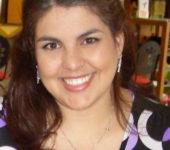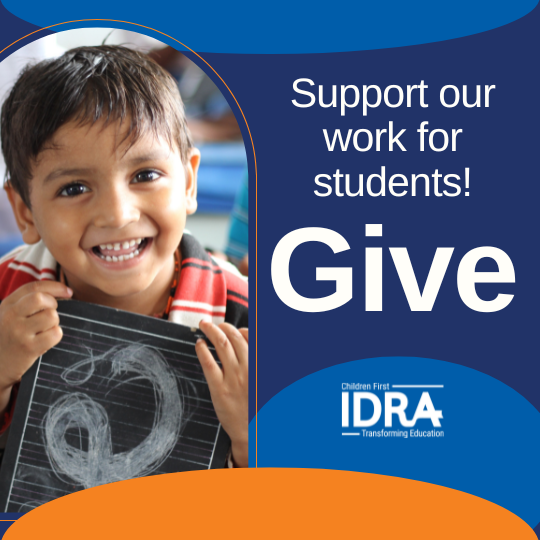• By Kathryn Brown and Veronica Betancourt, M.A. • IDRA Newsletter • April 2007
 “You’re going to have fun today in class! You’re going to get to design a rollercoaster and find all the slopes!” said a freshman talking in passing to another freshman as he walked out of his Algebra I class and the other entered.
“You’re going to have fun today in class! You’re going to get to design a rollercoaster and find all the slopes!” said a freshman talking in passing to another freshman as he walked out of his Algebra I class and the other entered.
In an urban, Title I school district in north-central Texas, 18 high school students restlessly await the start of their Algebra I class. It is already November, the semester now drawing to a close. But for many of these freshmen, living just outside the technology-rich “Silicon Prairie,” mathematics seemed pointless and irrelevant.
Then the rollercoaster lesson begins. Whether they realize it or not, these students know slopes. From mountains, sidewalk ramps and skateboard parks, they have an immediate sense of the gathering speed you achieve on a sharp incline or a sudden drop. They know rollercoasters, too. At home or in class, they are not 10 miles away from a Six Flags theme park.
Today, they will build the ride to end all rides. They will be rollercoaster engineers! They will first “ride a rollercoaster” with hands up in the air and stomachs turning as they watch a video that the teacher downloaded from the Internet to warm-up the students. Students will set the slopes and craft a model of wire ribbon and connecting cubes. They will draft a model to scale and will brainstorm the name that will send shivers down the spines of anticipating riders.
In the process, they will see how slope affects velocity and therefore the excitement of the ride. Students will calculate the slopes, the rise over the run, in real-space.
This is different from what they have done before when they had a worksheet with 25 problems where they had to find the slope of a line given two points that did not have relevance.
The teacher finds joy when students struggle with how to go about finding the slope of their heart-stopping drops. They compare their creations and go beyond the boundaries by taking on roles as project managers, design engineers and presenters to panels of students.
A student exclaims, “I always thought science was for smart kids, but this is really cool.” His teacher responds with excitement and sincerity, “You’re going to make me cry.”
In a science classroom in south San Antonio, the objective of the lesson will be for students to compare organisms from various kingdoms. A sample of pond water is brought in from a neighboring park where students often go to play basketball and hang out. As students collect samples, they return to their station, and the ooohs and aaahs of excitement begin to fill the room. “What’s this?!”, “Oooh, this is gross!” and “Check this out, it’s moving!”
Students begin to violate lab rules by moving back and forth from station to station to see what their peers are finding and compare them to their own discoveries. They are scientists in action – observing and noting what they find, comparing organisms that live in the same environment to each other and to themselves. Questions arise from the students as opposed from the teacher.
Students have taken ownership of their own learning with minimal direction from the teacher. The teacher is facilitating by extending students’ questions through cues and probes – an uplifting experience for everyone!
These are examples of what is possible in a classroom for students and teachers when an engaging math and science curriculum is in place. Students become engaged and see possibilities within themselves that are hidden and inaccessible when instruction was delivered in a traditional, teacher-centered, text-book reliant, worksheet-ridden environment. It is critical that we make math and science accessible for all students, value who they are and what they bring to the classroom and kick open the doors to opportunities, fields of study and careers that they have long been excluded from.
“In order to tap the riches of diversity, teachers must first believe that difference does not equal deficit” (Stodolsky and Grossman, 2000).
The possibilities become exponential for the students, their families, and for us as a society. Imagine the cures for diseases and new technologies that are behind the eye and in the mind of every child. It is a huge burden to carry knowing that we overlooked and dismissed that one child who could have changed the world, simply because the here and now moment was too much to make the adjustment needed to engage the kid.
Engaging Our Students in Math and Science… Now
So how do we do it? What needs to happen in the classroom? How do we make adjustments on the fly and move from text and test to teamwork and triumph? We must do the following.
Value Teachers as Curriculum Creators
Teachers are the artists of the canvas of learning, “The greater control that teachers have over their curricula, the greater their students’ achievement will be” (Wiseman and Brown, 2003). This gives teachers the opportunity to experience what it is to create lessons that connect and involve higher-order thinking questions. Pulling in external resources that connect to their students’ lives, they become more adept and break free of the confines of a scripted curriculum that is often designed as a one-size fits all agenda.
Connect Teachers with Professionals in their Fields
This could happen via internships in the summer, shadowing professionals in their area of study and connecting with them during the school year to work on problem- and project-based learning.
Release Teachers of the Burden of Being the Sole Provider of Knowledge
Teachers shift from direct instruction to facilitating activities unlike anything they have experienced as learners. They are the conductor “orchestrating classroom discourse so it moves students” from the role as receptor to that of the initiator of their own knowledge (Windschitl, 2006).
Have Dynamic Math and Science Curricula
We need to think of curriculum in a new dynamic way. Massachusetts Institute of Technology professor and world-renowned mathematician and educator, Seymour Papert asks us to think of curricula in a new way, replacing a system where students learn something on a scheduled day, with one where they learn something when they need it in an environment that shows meaning and gives context as to why it is being learned. It is student-centered where students use what they are learning (Curtis, 2001; Brown, 2006).
A dynamic curriculum goes beyond the textbook and its ancillaries. The National Commission on Excellence in Education’s A Nation at Risk found that textbooks were “of inadequate quality and rigor” and recommended that these tools (textbooks) of learning “should be upgraded and updated to assure more rigorous content” (NCEE, 1983).
Integrate a Multidimensional Math and Science Curriculum
A multidimensional curriculum encompasses various goals for a successful student. These include personal, academic and social goals by both the teacher and student. “Holding multiple goals may make it easier for teachers to change curriculum and instruction because change can be justified on more than one dimension” (Stodolsky and Grossman, 2000).
The National Research Council has recently argued that it is imperative that curricula be flexible so that teachers have the space to work with the current understanding that students bring into the class for meaningful integration with new knowledge (Bybee and Stage, 2005).
Value the Student and Create a Learning Environment that Promotes Risk
Math and science require risky ideas, new thoughts and innovative ideas. They are not prescribed with a “step-by-step” list of strategies guided by “what’s the next step” type of questioning or an experiment that is scripted to the results that “should” be found. Have open-ended experiments. Have open-ended questions that require students to tackle.
Engage Students from the Get Go
Spark interest and make a student wonder, “What if…?” It is this type of peaked interest that is the basis of science and math – making conjectures and hypotheses and proving and disproving, reanalyzing and applying, and is applicable to their lives. By incorporating various forms of media and resources within a warm-up that is timely and relevant to students’ lives, students’ minds can be charged-up as they prepare for learning in math and science. This could involve showing a video clip (available on the Internet) of a professional basketball game from the night before and asking students to make observations and find relationships from the box score data or asking students to find pseudo-science topics in newsstand magazines and debunk the headline with scientific evidence.
Listen to the Student Voices
Students interests and what they are involved in (skateboarding, soccer, working and helping to support their families, first English speakers) can provide the context to math and science content. Students should also listen to themselves by being reflective about learning math and science and self-assessing their knowledge. It is through their voices that we can discover new ways of learning knowledge and ask students how to improve the lesson and what they would do to change it, tweak it or vary it. Students have wonderful ideas!
Remind Ourselves that High-stakes Testing Doesn’t Ensure Engaging Curriculum in Math and Science
High-stakes testing has depleted teachers and students to industrialized methods of learning that give the illusion of efficient learning. The NCEE concluded, “The minimum competency testing that was spreading across states was leading to a decrease, rather than an increase, in standards” (Smith, 2004). High-stakes tests look at surface knowledge as opposed to deep understanding of content.
A change in a linear equation’s slope will transform its graph, no matter how slight the variation. Equally so, a slight increase in the amount of a chemical can significantly alter the results of the experiment, thus leading to new and undiscovered results. Such is the case for engaging math and science curricula.
So, while we inevitably juggle pressures of preparation time, time in class, class control, control of curriculum, curricular confines for students, and supporting students for student success, we can still see transformation and have students discover the mathematicians and scientists within them. It is the implementation of an engaging math and science curricula that will create these possibilities for all children.
Resources
Brown, K. “Re-Invigorating Math Curricula,” IDRA Newsletter (San Antonio, Texas: Intercultural Development Research Association, April 2006).
Bybee, R.W., and E. Stage. “No Country Left Behind,” Issues in Science and Technology (Winter 2005) 69-75.
Curtis, D. Start With the Pyramid (San Rafael, Calif.: The George Lucas Educational Foundation, 2001).
National Commission on Excellence in Education. A Nation At Risk: The Imperative For Educational Reform (Washington, D.C.: U.S. Department of Education, April 1983). http://www.ed.gov/pubs/NatAtRisk/risk.html.
Smith, T.M. “Curricular Reform in Mathematics and Science Since A Nation At Risk,” Peabody Journal of Education (2004) 79(1), 105-129.
Stodolsky, S.S., and P.L. Grossman. “Changing Students, Changing Teaching,” Teachers College Record (2000) 102(1), 125-172.
Weisman, A.W., and D.S. Brown. “Teacher Curricular Control and Student Performance: A Cross-National Study of Curricular Accountability,” Curriculum and Teaching Dialogue (2003) 5(2).
Windschitl, M. “Sparking the Debate Over Science Reform Education,” The Education Digest (January 2006) 20-31.
Kathryn Brown is an IDRA education associate. Veronica Betancourt, M.A., is an IDRA education associate. Comments and questions may be directed to them via e-mail at feedback@idra.org.
[©2007, IDRA. This article originally appeared in the April 2007 IDRA Newsletter by the Intercultural Development Research Association. Permission to reproduce this article is granted provided the article is reprinted in its entirety and proper credit is given to IDRA and the author.]



